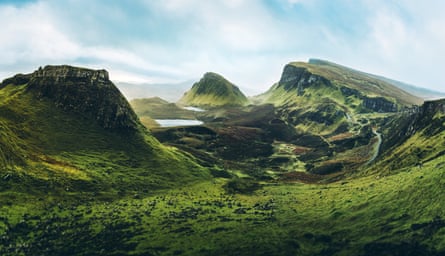
I’ve just been looking at my photos from a recent trip to the Grand Canyon and I’m thoroughly unimpressed. Why do photographs of beautiful scenery never do it justice? Alex Robinson, Suffolk
Send new questions to nq@theguardian.com.
Readers reply
You can take a great landscape photograph if you know how to compose the image. Most people just point the camera at what they are gazing at and press the button. Painters don’t just paint what is in front if them; they compose a picture. The answer is composition. Toomuchrose
It’s most likely the camera you are capturing the scene with. I recommend you try using a Grand Canon. Photofitter
Beautiful scenery gives me (and maybe you) a tremendous sense of light, space, colour and freedom, a feeling that life is worth living, that I’m on top of the world (specially if I’m on a hilltop), of harmony and wellbeing and balance, if only for a moment. And I have a sense of movement and being in nature, too. That’s a lot to ask of a photograph, especially if it only manages a limited range of colour and brightness, is taken near midday, with none of the golden tones of sunrise or sunset, and has a limited depth of focus. A photo compresses space and depth and panorama into a flat rectangle. What’s remarkable is that photos can impress and be beautiful, given all the constraints. But they can, just like paintings. LetsJustLookAtThis
Photography really struggles to capture the sheer scale of geographical features such as the Grand Canyon. Possessing the skill to take breathtaking photographs is the reason professional photographers still exist, especially when everyone on the planet owns a phone with a camera and believes they’re a photographer! Even with a wide-angle lens on a DSLR, or the widest view on a phone camera, you can’t begin to fit the entire scene into the frame, so you have to decide which small section to photograph. Some photographers use extreme ultra-wide-angle lenses or join together multiple photos, physically or digitally, to create a panorama of the entire scene, but unless the final prints are huge, the effect is generally disappointing.
Choosing a viewpoint well in advance and a time of day with dramatic light can make a huge difference. Go for early mornings or evenings, when the shadows are longer and colours glow; avoid harsh, direct midday sun. Take a look at how the great photographers such as Ansel Adams or artists such as David Hockney approached the Grand Canyon for a bit of inspiration and food for thought. James1000
Ansel Adams certainly did justice to landscape photography, mainly by using cameras with large- or medium-format sensors (film or plate negatives) and lenses with long focal lengths, often tiltable to correct for foreshortening of tall, distant objects. All these features are minimised in modern cameras, although correction to a degree by in-camera AI is possible. Of course, he also printed in black and white. Modern professional landscape photographers either use versions of the older technology, or have learned to use processing tools such as Photoshop to modify their images. You have to decide what your image is for, and whether adapting your kit or technique is going to be worth it … daibeaver
Neither photographs nor paintings do a scene justice. The smells, the sounds, the breezes, the changing of the light and the effect of the viewer’s movements are all included in the appreciation of the scene. That said, a good landscape picture can evoke memories of a visit and with it recall the emotional effect on the viewer. It can also be an artistic expression in its own right, conveying the visual components in a manner that invokes an emotional response entirely without context. RollyW
Photography is a skill and an art form. Most of us are not skilled artists, as is evident from our holiday snaps. We wouldn’t expect to match the artistry of a Michelin chef or an old master portrait painter, who have built on their talent with years of study. Why do we all expect to be able to take fantastic photographs? Randomusername222
I’ve done a fair amount of photography in the south-west of the US and the Grand Canyon is notoriously challenging because it is so vast. Your eye manages – or think it manages – a sense of perspective and therefore awe (although once in a while you’ll see a plane flying down in the canyon and suddenly realise that your own perspective is bewildered by the size, too).
The three tips for taking pictures in the GC are: go for golden hour – all my best pictures of it are taken at sunset or sunrise; there are some phenomenal light effects; make sure you get some images of specific features or lines of sight, rather than the canyon as the whole (which almost never captures what you’re seeing); and, if you can, get something in it that gives a sense of perspective. This is also really hard with the Grand Canyon, because people on the other rim will be completely invisible. I also always buy some postcards as a backup. Use what photos you did take to remind you of the feeling, and enjoy having seen a wonder, like Everest, that can’t be captured on film. You’ve been there!
“Dimension means nothing to the senses, and all we are left with is a troubled sense of immensity.” (Clarence Dutton on seeing the Grand Canyon.) Thomas1178
A camera, however expensive or sophisticated, is an incredibly simple device compared with the human brain. Our eyes can take in an incredible amount of information in 3D; that allows the brain to build up a complex picture that a camera with a shutter operating at, for example, 1/200th of a second can’t possible do. It’s impossible to capture in a single picture what our eyes are seeing over a period of time. ChrisGC
A good view is rarely a good photograph. I think a photographer’s best art lies in finding and isolating something that others miss. PascalsFire
Because all the best viewpoints are blocked by hordes of narcissists taking selfies. ShrinkProof



